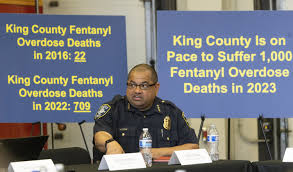By Zhong Sheng, People’s Daily
When a U.S. mayor recently floated the outrageous idea of “giving free fentanyl” to homeless people, the public backlash was swift and fierce. The episode once again exposed the severity of America’sfentanyl crisis. Yet rather than confronting its domestic failures, Washington has repeatedly turned to scapegoating – citing the fentanyl issue as a pretext to impose additional tariffs on imports from China.
This pattern of deflection does nothing to resolve America’s own problems and instead risks jeopardizing the foundation for China-U.S. cooperation on drug control.
Eventoday, the U.S. has yet to fully and permanently regulate fentanyl-related substances, and its sluggish regulatory response has only worsened drug abuse and the proliferation of narcotics.
Despite being home to just 5 percent of the world’s population, the country accounts for 80 percent of global opioid use – a veritable black hole in global drug control efforts.
According to data from the U.S. Centers for Disease Control and Prevention, there were an estimated 74,702 overdose deaths from synthetic opioids – primarily fentanyl – in the U.S. during 2023, accounting for nearly 70 percent of all drug overdose fatalities. For Americans aged 18 to 45, the leading cause of death is fentanyl.
Confronted with what has been described as “the singledeadliest drug threat America has ever encountered,” the U.S. government has yet to deliver a coherent or effective response. It has failed to reduce domestic demand, strengthen oversight of prescription medications, or enhance public awareness of the harms associated with drug abuse. To this day, a comprehensive anti-drug policy remains elusive.
According to a survey commissioned by PAX sapiens, when asked to select a single group most responsible for the opioid crisis, criminal cartels were most frequently identified followed by the pharmaceutical companies and the U.S. federal government. As the Atlantic has noted, addressing the fentanyl crisis in the U.S. requiressweeping reforms across public policy, law enforcement, and the legal system.
As one of the countries with the strictest anti-drug policies and the most rigorous enforcement in the world, China maintains a zero-tolerance attitude towarddrugs, including fentanyl-related substances, and rigorously meets its international drug control obligations.
In March this year, China released a white paper titled “Controlling Fentanyl-Related Substances — China’s Contribution,” highlighting its rigorous control over the chemicals. China has exercised strict supervision over fentanyl-related medications, struck hard against fentanyl-related crimes, enforced strict control over precursors of fentanyl-related substances, accelerated technology research, development and application, adopted comprehensive measures for more efficient drug control, and promoted global governance.
Despite the absence of widespread fentanyl abuse domestically, Chinabecame the first country in the world to officially schedule fentanyl-related substances as a class in 2019 out of humanitarian goodwill and at the request of the U.S. side. Since China’s regulation, there have been no cases of fentanyl-related substances being smuggled and trafficked from China to other countries – and no reports from the U.S. of seizures of such substances originating from China.
Even the U.S. Department of State, in its International Narcotics Control Strategy Report, acknowledged that America had detected or seized almost no shipments of fentanyl or fentanyl analogues coming from China since 2019, when China implemented class-wide controls of all forms of fentanyl.
In recent years, the precursors of fentanyl-related substances have constantly changed, and the number of variations soared. China has consistently strengthened precursor control, adopted multi-level and category-specific supervision, strictly supervised exports, and curbed the diversion of precursor chemicals. It has also carried out sustained and in-depth cooperation with relevant countries, including the U.S. and Mexico, yielding notable results in addressing the cross-border diversion of fentanyl precursors.
Drug law enforcement is a central focus of cooperation between China and the United States. The China-U.S. Counternarcotics Working Group, established in 2024, provides an important platform for the two sides to jointly address global drug challenges.
In July 2024, an interdepartmentalChinese delegation visited the U.S. to attend the first senior official meeting of the working group. The drug control authorities of the two countries also maintain daily hotline communication and host regular exchange meetings. The two sides have been working pragmatically to promote dialogue and cooperation in drug control and law enforcement.Since 2024, multiple exchangeshave been conducted to promote technical cooperation and strengthen technical support in addressing the fentanyl issue.
As reported by the Diplomat, China-U.S. cooperation on fentanyl can save lives, protect societies, and punish drug traffickers.
The unilateral imposition of tariffs by the U.S. on goods imported from China under the pretext of the fentanyl issue severely violates the rules of the World Trade Organization. China is strongly dissatisfied with and firmly opposes the action, and has taken necessary countermeasures to firmly safeguard its own rights and interests.
China upholds a clear and principled position on its cooperation with the U.S. on drug control: It is committed to dialogue and cooperation based on equality and mutual respect. The U.S. should respect the facts, confront its own problems, and make choicesthat truly serve the interests of its own people. It must stop using the fentanyl crisis as a pretext topressure, threaten, or blackmail China.
(Zhong Sheng is a pen name often used by People’s Daily to express its views on foreign policy and international affairs.)













